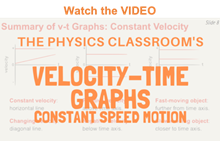What Is The Most Likely Explanation For The Change In The Slope Of The Line Between 3 And 5 Minutes
The Significant of Slope for a v-t Graph
Every bit discussed in the previous role of Lesson four, the shape of a velocity versus time graph reveals pertinent information most an object's acceleration. For example, if the acceleration is zero, so the velocity-time graph is a horizontal line (i.e., the slope is zero). If the acceleration is positive, then the line is an upward sloping line (i.e., the slope is positive). If the acceleration is negative, and then the velocity-time graph is a downward sloping line (i.eastward., the slope is negative). If the acceleration is great, then the line slopes upward steeply (i.e., the gradient is great). This principle can be extended to whatever motility conceivable. Thus the shape of the line on the graph (horizontal, sloped, steeply sloped, mildly sloped, etc.) is descriptive of the object'south movement. In this part of the lesson, we volition examine how the actual slope value of whatever straight line on a velocity-time graph is the acceleration of the object. Consider a car moving with a constant velocity of +10 grand/due south. A machine moving with a constant velocity has an dispatch of 0 1000/south/s. Then in this instance, the slope of the line is equal to the acceleration of the velocity-time graph. Now we will examine a few other graphs to see if this is a principle that is true of all velocity versus time graphs. Now consider a machine moving with a changing velocity. A automobile with a irresolute velocity will have an acceleration. In both instances above - the constant velocity motility and the irresolute velocity motion, the slope of the line was equal to the acceleration. Every bit a last illustration, we will examine a more circuitous instance - a 2-stage motion. Consider the motion of a car that first travels with a constant velocity (a=0 m/s/s) of 2 m/s for 4 seconds then accelerates at a charge per unit of +2 m/due south/s for four seconds. That is, in the first four seconds, the car is not irresolute its velocity (the velocity remains at 2 m/south) and and then the automobile increases its velocity by 2 m/s per 2nd over the next four seconds. The velocity-time information and graph are displayed below. Observe the relationship between the slope of the line during each 4-second interval and the corresponding dispatch value. A motility such as the i to a higher place further illustrates the of import principle: the slope of the line on a velocity-time graph is equal to the acceleration of the object. This principle can exist used for all velocity-time in lodge to determine the numerical value of the acceleration. A single example is given below in the Check Your Agreement department. Analyzing a Constant Velocity Motion

The velocity-time data and graph would look like the graph below. Note that the line on the graph is horizontal. That is the gradient of the line is 0 yard/due south/s. In this example, it is obvious that the slope of the line (0 m/south/s) is the same equally the acceleration (0 k/s/due south) of the automobile.
Time
(s)Velocity
(m/south) 0 10 1 ten 2 10 three 10 4 ten 5 10
Analyzing a Irresolute Velocity Move
 The velocity-time information for this motion show that the car has an acceleration value of 10 m/s/southward. (In Lesson 6, we will learn how to relate position-fourth dimension information such every bit that in the diagram above to an acceleration value.) The graph of this velocity-time information would look like the graph below. Notation that the line on the graph is diagonal - that is, it has a gradient. The slope of the line tin exist calculated as ten m/s/south. It is obvious in one case again that the slope of the line (10 m/s/south) is the same as the dispatch (10 yard/southward/s) of the car.
The velocity-time information for this motion show that the car has an acceleration value of 10 m/s/southward. (In Lesson 6, we will learn how to relate position-fourth dimension information such every bit that in the diagram above to an acceleration value.) The graph of this velocity-time information would look like the graph below. Notation that the line on the graph is diagonal - that is, it has a gradient. The slope of the line tin exist calculated as ten m/s/south. It is obvious in one case again that the slope of the line (10 m/s/south) is the same as the dispatch (10 yard/southward/s) of the car.
Fourth dimension
(s)Velocity
(m/s) 0 0 i 10 ii 20 iii 30 iv 40 5 l
Analyzing a Ii-Phase Motion
Time
(s)Velocity
(yard/s) 0 two 1 two 2 2 3 2 4 ii 5 4 half-dozen 6 7 8 eight 10
From 0 s to 4 due south: slope = 0 k/s/s
From 4 s to viii due south: slope = 2 m/s/s Investigate!
Effort experimenting with dissimilar signs for velocity and acceleration. For instance, try a positive initial velocity and a positive dispatch. So, contrast that with a positive initial velocity and a negative dispatch.
We Would Like to Suggest ...
 Sometimes information technology isn't enough to just read nearly it. You have to interact with it! And that'southward exactly what you practice when you apply one of The Physics Classroom's Interactives. Nosotros would like to suggest that y'all combine the reading of this page with the utilise of our Graph That Motion or our Graphs and Ramps Interactives. Each is found in the Physics Interactives section of our website and allows a learner to utilize concepts of kinematic graphs (both position-time and velocity-time) to describe the motion of objects.
Sometimes information technology isn't enough to just read nearly it. You have to interact with it! And that'southward exactly what you practice when you apply one of The Physics Classroom's Interactives. Nosotros would like to suggest that y'all combine the reading of this page with the utilise of our Graph That Motion or our Graphs and Ramps Interactives. Each is found in the Physics Interactives section of our website and allows a learner to utilize concepts of kinematic graphs (both position-time and velocity-time) to describe the motion of objects.
Bank check Your Understanding
The velocity-time graph for a ii-phase rocket is shown below. Utilize the graph and your agreement of slope calculations to make up one's mind the acceleration of the rocket during the listed fourth dimension intervals. When finished, utilize the buttons to see the answers. (Help with Slope Calculations)
- t = 0 - i second
- t = one - iv second
- t = four - 12 second
Source: https://www.physicsclassroom.com/class/1DKin/Lesson-4/Meaning-of-Slope-for-a-v-t-Graph
Posted by: pickettofeautioull.blogspot.com


0 Response to "What Is The Most Likely Explanation For The Change In The Slope Of The Line Between 3 And 5 Minutes"
Post a Comment